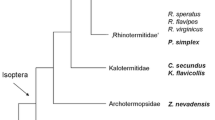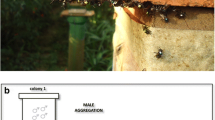Abstract
In the primitively eusocial wasp Ropalidia marginata, mating is not necessary for a female wasp to develop her ovaries, lay eggs, and even to become the sole egg layer of her colony despite the presence of other mated nestmates. Here, we show that virgin wasps do not differ from their mated counterparts in the extent and rapidity of their ovarian development, in the proportion of individuals that build a nest and laid eggs, and in the time taken to do so. However, a significantly larger proportion of virgin females showed resorbing oocytes, and laid fewer eggs as compared to mated individuals. Thus, virgin females have the ability to develop ovaries and lay eggs but also to refrain from necessarily laying all mature eggs produced, before mating opportunities arise. This dual ability would be adaptive in haplodiploid, tropical species with perennial nesting cycles and frequent opportunities for workers to become replacement queens or solitary nest foundresses throughout the year.

Similar content being viewed by others
References
Arnqvist G. and Nilsson T. 2000. The evolution of polyandry: multiple mating and female fitness in insects. Anim. Behav. 60: 145–164
Bloch Qazi M., Heifetz Y. and Wolfner M. 2003. The developments between gametogenesis and fertilisation: ovulation and female sperm storage in Drosophila melanogaster. Dev. Biol. 256: 195–211
Bourke A.F.G. 1988. Worker reproduction in the higher eusocial Hymenoptera. Q. Rev. Biol. 63: 291–311
Chandrashekara K. and Gadagkar R. 1991a. Behavioral castes, dominance and division of labour in a primitively eusocial wasp. Ethology 87: 269–283
Chandrashekara K. and Gadagkar R. 1991b. Unmated queens in the primitively eusocial wasp Ropalidia marginata (Lep.) (Hymenoptera: Vespidae). Insect. Soc. 38: 213–216
Chandrashekara K. and Gadagkar R. 1992. Queen succession in the primitively eusocial tropical wasp Ropalidia marginata (Lep.) (Hymenoptera: Vespidae). J. Insect Behav. 5: 193–209
Davey K.G. 1997. Hormonal controls on reproduction in female Heteroptera. Arch. Insect Biochem. 35: 443–453
de Souza E.A., Neves C.A., Campos L.A.O., Aanuncio J.C. and Serrao J.E. 2007. Effect of mating delay on the ovary of Melipona quadrifasciata anthidioides (Hymenoptera: Apidae) queens. Micron 38: 471–477
Downing H.A. 2004. Effect of mated condition on dominance interactions and nesting behavior in the social wasp, Polistes fuscatus (Hymenoptera: Vespidae). J. Kansas Entomol. Soc. 77: 288–291
Dropkin J.A. and Gamboa G.J. 1981. Physical comparisons of foundresses of the paper wasp, Polistes metricus (Hymenoptera: Vespidae). Can. Entomol. 113: 457–461
Gadagkar R. 2001. The Social Biology of Ropalidia marginata: Toward Understanding the Evolution of Eusociality. Harvard University Press, Cambridge, Massachusetts
Gadagkar R., Bhagavan S., Malpe R. and Vinutha C. 1991a. Seasonal variation in the onset of egg laying in a primitively eusocial wasp: implications for the evolution of sociality. Entomon 16: 167–174
Gadagkar R., Bhagavan S., Chandrashekara K. and Vinutha C. 1991b. The role of larval nutrition in pre-imaginal biasing of caste in the primitively eusocial wasp Ropalidia marginata (Hymenoptera: Vespidae). Ecol. Entomol. 16: 435–440
Gadagkar R., Chandrashekara K., Chandran S. and Bhagavan S. 1993. Serial polygyny in the primitively eusocial wasp Ropalidia marginata: implications for the evolution of sociality. In: Queen Number and Sociality in Insects (Keller L., Ed), Oxford University Press, Oxford. pp 188–214
Gadagkar R., Gadgil M., Joshi N.V. and Mahabal A.S. 1982. Observations on the natural history and population ecology of the social wasp Ropalidia marginata (Lep.) from peninsular India (Hymenoptera: Vespidae). Proc. Indian Acad. Sciences (Animal Sciences) 91: 539–552
Gadagkar R., Vinutha C., Shanbhogue A. and Gore A.P. 1988. Pre-imaginal caste biasing of caste in a primitively eusocial insect. Proc. R. Soc. Lond. B Biol. 233: 175–189
Gobin B., Peeters C. and Billen J. 1998. Production of trophic eggs by virgin workers in the ponerine ant Gnamptogenys menadensis. Physiol. Entomol. 23: 329–336
Harrell F.E. Jr. 2013. Rms: Regression modeling strategies. R package version 3.6-3
Horner V.L. and Wolfner M.F. 2008. Transitioning from egg to embryo: triggers and mechanism of egg activation. Dev. Dynam. 237: 527–544
Henter H.J. 2003. Inbreeding depression and halpodiploidy: experimental measures in a parastioid and comparisons across diploid and haplodiploid insect taxa. Evolution 57: 1793–1803
Jemielity S., Graff J. and Keller L. 2006. How to fool a virgin: Artificial dealation triggers oviposition in virgin Lasius niger queens. Insect. Soc. 53: 323–325
Karsai I. and Hunt J.H. 2002. Food quantity affects traits of offspring in the paper wasp Polistes metricus (Hymenoptera: Vespidae). Environ. Entomol. 31: 99–106
King P.E.1962. The effect of resorbing eggs upon the sex ratio of the offspring in Nasonia vitripennis (Hymenoptera, Pteromalidae). J. Exp. Biol. 39: 161–165
Melo G.A.R., Buschini M.L.T. and Campos L.A.O. 2001. Ovarian activation in Melipona quadrifasciata queens triggered by mating plug stimulation. Apidologie 32: 355–361
Muralidharan K., Shaila M.S. and Gadagkar R. 1986. Evidence for multiple mating in the primitively eusocial wasp Ropalidia marginata (Lep.) (Hymenoptera: Vespidae). J. Genet. 65: 153–158
Ohgushi T. 1996. A reproductive trade-off in an herbivorous lady beetle: egg resorption and female survival. Oecologia 106: 345–351
Pardi L. and Marino Piccioli M.T. 1970. Studi sulla biologia di Belanogaster griseus (Hymenoptera: Vespidae). 2. Differenziamento castale incipiente in B. griseus (Fab.). Mon. Ital. Zool. 3: 235–265
Peer K. and Taborsky M. 2005. Outbreeding depression, but no inbreeding depression in haplodiploid ambrosia beetles with regular sibling mating. Evolution 59: 317–323
Patricio K. and Cruz-Landim C. 2007. Effect of mating delay in the ovary of Apis mellifera queens: histological aspects. Braz. J. Morphol. Sci. 24: 25–28
Peeters C. and Crewe R.M. 1984. Insemination controls the reproductive division of labour in a ponerine ant. Naturwissenschaften 71: 50–51
Peso M., Niño E.L., Grozinger C.M. and Barron A.B. 2013. Effect of honey bee queen mating condition on worker ovary activation. Insect. Soc. 60: 123–133
Pinheiro J., Bates D., DebRoy S., Sarkar D. and the R Development Core Team. 2013. nlme: Linear and Nonlinear Mixed Effects Models. R package version 3.1–108
Plateaux-Quénu C. and Packer L. 1998. A test of the mating limitation hypothesis for caste determination in Evylaeus albipes (Hymenoptera: Halictidae), a primitively eusocial Halictine bee. J. Insect Behav. 11: 119–128
R Development Core Team 2012. R: A language and environment for statistical computing. R foundation for statistical computing, Vienna, Austria
Raabe M. 1986. Insect reproduction: regulation of successive steps. In: Advances in Insect Physiology (Evans P.D. and Wigglesworth V.B., Eds), Academic Press, London. pp 30–154
Richards M.H. and Packer L. 1996. The sociobiology of body size variation in the primitively eusocial sweat bee, Halictus ligatus (Hymenoptera: Halictidae). Oikos 77: 68–76
Saito Y., Sahara K. and Mori K. 2000. Inbreeding depression by recessive deleterious genes affecting female fecundity of a haplo-diploid mite. J. Evol. Biol. 13: 668–678
Sen R., Samudre S., Shilpa M.C., Chitra Tarak R. and Gadagkar R. 2010. Middle aged wasps mate throughout most of the year, without regard to body size, ovarian development and nestmateship: a laboratory study of the primitively eusocial wasp Ropalidia marginata. Insect. Soc. 57: 95–103
Shilpa M.C., Sen R. and Gadagkar R. 2010. Nestmateship and body size do not influence mate choice in males and females: A laboratory study of a primitively eusocial wasp Ropalidia marginata. Behav. Proc. 85: 42–46
Shilpa M.C., Sen R., Samudre S. and Gadagkar R. 2012. Males, but not females, mate with multiple partners: a laboratory study of a primitively eusocial wasp Ropalidia marginata. Insect. Soc. 59: 61–65
Shukla S., Chandran S. and Gadagkar R. 2013. Ovarian developmental variation in the primitively eusocial wasp Ropalidia marginata suggests a gateway to worker ontogeny and the evolution of sociality. J. Exp. Biol. 216: 181–187
Suzuki T. 1997. Worker mating in queen-right colonies of a temperate paper wasp. Naturwissenschaften 84: 304–305
Tanaka E.D. and Hartfelder K. 2004. The initial stages of oogenesis and their relation to differential fertility in the honey bee (Apis mellifera) castes. Arthropod Struct. Dev. 33: 431–442
Werren J.H. 1993. The evolution of inbreeding in haplodiploid organisms. In: The Natural History of Inbreeding and Outbreeding: Theoretical and Empirical Perspectives (Thornhill N., Ed), University of Chicago Press, Chicago. pp 42–59
West-Eberhard M.J. 1969. The social biology of the polistine wasps. Misc. Publ. Mus. Zool. Univ. Mich. 140: 1–101
Yanega D. 1992. Does mating determine caste in sweat bees? (Hymenoptera: Halictidae). J. Kansas Entomol. Soc. 65: 231–237
Yanega D. 1997. Demography and sociality in Halictine bees (Hymenoptera: Halictidae). In: The Evolution of Social Behavior in Insects and Arachnids (Crespi B.J. and Choe J., Eds). Cambridge University Press, Cambridge, pp 293–315
Acknowledgments
This work was supported by grants from the Department of Science and Technology, Department of Biotechnology, the Council of Scientific and Industrial Research, and the Ministry of Environment and Forests, Government of India. RG and SS designed the study, SS performed dissections and data analysis, MCS carried out behavioural observations, body size measurements and maintained wasps, RG supervised the work and SS and RG co-wrote the paper. We thank Ruchira Sen and two anonymous referees for helpful comments on an earlier version of the manuscript.
Author information
Authors and Affiliations
Corresponding author
Rights and permissions
About this article
Cite this article
Shukla, S., Shilpa, M.C. & Gadagkar, R. Virgin wasps develop ovaries on par with mated females, but lay fewer eggs. Insect. Soc. 60, 345–350 (2013). https://doi.org/10.1007/s00040-013-0299-1
Received:
Revised:
Accepted:
Published:
Issue Date:
DOI: https://doi.org/10.1007/s00040-013-0299-1




